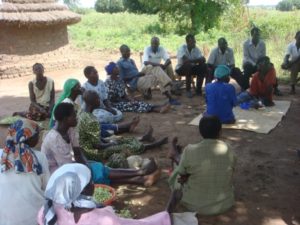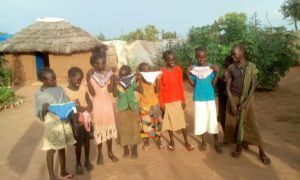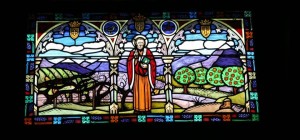
Menu

This Friday, October 18 from 5 to 7:30 p.m.
on the Parish School Playground
The Parish School’s annual fall Barbeque is next Friday evening. All are invited for food, fun, and an opportunity to connect with the families of the All Saints Parish School. This old-fashioned BBQ will have music for dancing and face painting for kids. The event is organized by the Parish School Parent Council and is open to everyone from All Saints. Contact Padric, the Parish School Director, for more information, or click here to learn more about the All Saints Parish School.
Learn MoreThe emotional impact of a natural disaster is not much different from the legacy of trauma endured by civilians who have survived conflict. As the Santa Barbara area comes to terms with recent events, there is a new empathy toward those further afield who have experienced unimaginable loss and shock. There is also a shared understanding of what it feels like to always be bracing yourself for the next unpleasant surprise. This is why counseling and sharing is so important.

All Saints by the Sea Outreach Committee has kindly supported a six-month pilot project offering psychotherapy counseling to orphans who survived the Rwandan genocide. Despite the difference in location, cause and scale, Santa Barbara’s survivors share common challenges. They will also benefit from similar coping mechanisms.
The Rwanda pilot project was run by Network for Africa, a charity supported by All Saints since 2009. The orphans being counseled had an average age of 28 (the genocide was in 1994, but there has been almost no treatment for survivors in this profoundly poor country). We interviewed the orphans at the start of the project, and again when it ended, in an attempt to measure our impact. At the start, only 6% of the orphans felt positive about their lives. By the end, 62% felt optimistic – a remarkable result, given the orphans’ early experiences, witnessing the murder of their families, and the decades of PTSD since.
When the Rwandan orphans were asked how they were functioning and making plans for the future, few expressed any hope at the beginning of the project. By the end, there was a 57% improvement (the figures were arrived at by a standard measurement method employed by Network for Africa’s trained psychotherapists). At the start, only 60% felt able to find work and hold down a job; that rose to 88% by the end of the pilot project.
In the course of individual interviews, the orphans described what aspects of the counseling helped them most. Anyone who is a survivor of the wild fires and mudslides closer to home may find the young Rwandans’ comments resonate. The orphans regularly use the coping skills and strategies taught to them by Network for Africa (breathing exercises, visualizing a safe place, reflecting on the positive aspects of their life, writing down their problems and then burning the piece of paper, listening to music, finding peace and quiet on a walk, in the garden, or being with animals).
In particular, the orphans reported opening their hearts and minds to “feel the healing light.” They drew enormous strength from talking to counselors and other survivors about their experiences, and in prayer.
Network for Africa thanks All Saints for its generous support for this pilot project. In March 2019, a group from Santa Barbara, including All Saints parishioners, will visit Rwanda to see similar life-enhancing projects, witnessing the resourcefulness and resilience of survivors. An optional safari and gorilla-watching trek will also be offered. Those interested please contact Rebecca Tinsley of Network for Africa (a part-time Santa Barbara resident) who will lead the tour: tinsleyrc@aol.com
Learn More2016
 In some parts of Africa, a bra can save a women’s life. If a potential rapist sees a woman is wearing one, he will think she has a husband who has given her the money to buy one – in other words, she “belongs” to a man – and the would-be attacker will leave the woman alone.
In some parts of Africa, a bra can save a women’s life. If a potential rapist sees a woman is wearing one, he will think she has a husband who has given her the money to buy one – in other words, she “belongs” to a man – and the would-be attacker will leave the woman alone.
That is why Network for Africa has shipped boxes of second hand underwear to parts of Africa where women and girls face daily terror at the hands of men. Unfortunately, officials on the continent are
clamping down on allowing second hand clothing donations in. However, we have joined with Diaspora groups who take bundles of underwear with them when they visit their countries of origin.
The photographs here show a Sudanese refugee in the UK with one of our boxes; and the recipients,
in South Sudan, which has one of the highest rates of rape and sexual assault in the world. We also
send underpants, by the way. Having underpants makes it easier for girls to attend school at all
times of the month. As so often, it is these simple fixes that have a big impact on people’s lives.
Sadly, it isn’t practical to send boxes of second hand clothes from the States. However, we hope All
Saints and Network for Africa will have a pilgrimage to Rwanda in 2019, and everyone will be
encouraged to bring second hand clothing (especially children’s garments, which are expensive in
Africa) in their luggage – so start collecting from your friends now, please. For more information,
contact Becky Tinsley at TinsleyRC@aol.com
All Saints has kindly supported Network for Africa for several years. As a way of saying thank you, we
hope you enjoy the smiles on the faces of the girls in South Sudan, with their treasured almost-new
clothes.
Check out an online photo album from our most recent celebration of this most noteworthy of saints. Just click this link or click on the image below.

All Saints celebrated St. Nicholas with a special children’s worship service and marketplace. Click on the image above to relive the day in photos!
An ancient merchant had three lovely daughters. But due to a tragic turn of events, he had lost all hope that his daughters would be able to marry and live a happy life. It was the third century, and this businessman had lost his fortune when pirates pillaged his ship. His beautiful daughters were of marrying age, and without money he could give them no dowry.
In those days, young women without a dowry had few options for survival. Many were forced into slavery or prostitution.
The father prayed around the clock that somehow God would grant a miracle for his family. A young Christian bishop discovered the plight of this man and his daughters. This bishop was a wealthy man, having received a large inheritance at the death of his parents. One evening, in the middle of the night, the bishop secretly slipped a sack of gold through a window into the merchant’s house. This timely gift saved the virtue of the man’s oldest daughter.
 Later, another sack saved the second daughter.
Later, another sack saved the second daughter.
Anticipating a third gift of gold, the father determined to discover who was helping his family. He stayed up all night and when the sack was dropped through the window, the father ran down the road and apprehended the mysterious benefactor. The merchant immediately recognized the young bishop and tried to give thanks to him.
The humble minister deflected the praise. “No, all thanks go to God, not to me.”
The father answered, “I need to let everybody know you did this.”
The bishop responded, “No, you must promise me that not until I’m dead will you let anyone know how you received the gold.” This compassionate bishop believed literally Christ’s injunction that when we give, we should do so in secret, sacrificially in Christ’s name and not our own.
The merchant promised that he would tell no one of the way this minister helped save this family. And it wasn’t until after his death that the world learned the numerous stories of the generosity of this bishop of the early Church, Saint Nicholas.
Through his timely gifts, Saint Nicholas helped to restore the hope of this family, and hundreds more in his community. But the ministry of Bishop Nicholas extended beyond giving gifts. History tells us that he was persecuted by the Roman authorities and imprisoned for his faith. Later, when Emperor Constantine made Christianity the state religion, Nicholas boldly defended the doctrine of the Trinity at the Council of Nicea.
Throughout his ministry, Bishop Nicholas selflessly poured out his life and his fortune as he served the people in and around his home. CBN
According to the Saint Nicholas Center Web site, after the American Revolution, New Yorkers were looking to break with British tradition, and they remembered with pride the colony’s nearly-forgotten Dutch roots. John Pintard, an influential patriot who founded the New York Historical Society in 1804, promoted St. Nicholas as the patron saint of both the society and the city.
In January 1809, Washington Irving published the satirical Knickerbocker’s History of New York, which made numerous references to a jolly St. Nicholas character. This was not a saintly European bishop, but rather a Dutch burgher with a clay pipe. The jolly elf image received a big boost in 1823 from a poem destined to become immensely popular, “A Visit from St. Nicholas,” — now better known as “The Night Before Christmas.”
Washington Irving’s St. Nicholas strongly influenced the poem’s portrayal of a round, pipe-smoking, elf-like St. Nicholas. The poem generally has been attributed to Clement Clark Moore, a professor of biblical languages at New York’s Episcopal General Theological Seminary.
In North America, the popular name Santa Claus was taken from the Dutch Sinterklaas, which originated with a contracted form of Sint Nicolaas (Saint Nicholas). The “Mall Santa” that we are all familiar with — sporting a red suit with white cuffs and collar, and black leather belt, became the popular image in the United States in the late 19th century and early 20th century because of the “Merry Old Santa Claus” images created by political cartoonist Thomas Nast.
Beginning in 1863, Nast began a series of annual drawings in Harper’s Weekly that were inspired by the descriptions found in Washington Irving’s work. These drawings established a rotund Santa with flowing beard, fur garments, and a clay pipe. Nast drew his Santa until 1886, and his work had a major influence in creating the modern American Santa Claus.
In the mid-20th Century a series of Coca-Cola advertisements featuring a rotund and jovial Santa Claus was drawn by artist Haddon Sundblom and further popularized Nast’s depiction.
There are, of course, controversial aspects of the American Santa Claus fiction. Some Christians believe he takes the focus of Christmas away from Jesus Christ, placing it on a fictional character with little redemptive value. Others insist that it is unhealthy for parents to lie to their children to enforce their belief in Santa Claus. And others say that Santa Claus is a symbol of the commercialization and consumerism that has seized the Christmas holiday in the West. Still for others, Santa Claus and the modern celebration of Christmas is seen as an intrusion upon their own national traditions.
But beneath all the symbolism and tradition that has been attached to the modern American Santa Claus, he, like so many other “Father Christmas” characters before him can hearken back to a simple Christian bishop who loved God and loved people. Bishop Nicholas displayed his love through the giving of gifts, just as our Heavenly Father gave the gift of His Son to us that first Christmas morning 2000 years ago.
In this season, we celebrate how God gave His Son, Jesus, to bring hope to the world. May each of us prayerfully consider how we, like Nicholas, can give of ourselves to help restore hope to those that God brings into our lives. CBN
Learn MoreDr. Anne Plane, professor of history at UCSB and parishioner at ASBTS, will continue the discussion on the development of the Episcopal Church begun by Dr. Sears McGee in his two-part lecture on the Reformation in September. Join us on Wednesday evenings, November 1 and 8, in the Parish House living room at 7:30 p.m. Dr. Plane’s lecture will focus on the impact of the Reformation on the New World and the emerging Episcopal Church.
November 1: Christianizing the New World
The colonization of the Americas played out at the same time as the Protestant Reformation and Catholic Counterreformation changed the map of Europe. Religious conflict – Catholic vs Protestant and the established church vs dissenters – often motivated colonization in the New World. This session shows some of the impact of the Reformation on colonization efforts and on the missionization of Native Americans and African American peoples.
November 8: Anglicans and Episcopalians
Dissenters from the Anglican church played a major role in most of the English colonies of North America. What role did the Anglican church play in the diversity of colonial religion and in what ways did it stand in the larger political conflict between the colonies and Britain? This section focuses on religious awakening, dissenter protest, and the conflicts that brought the American Episcopal Church into being.
Learn MoreCLEVELAND SCHOOL FOCUS PROJECT
In 2014 Cleveland Elementary School was chosen to be the Outreach Focus Project. One-third of our Outreach budget and many volunteers have focused on this vibrant energetic school for three and a half years. We have watched the school change and grown while we have established friendships with the staff, the teachers and especially the students.
We have ten weekly and three seasonal volunteers who will are committed to their work at Cleveland, as one volunteer exclaimed, “My time at Cleveland has become the best part of my week.” They are involved in the classroom, the library, and the office and the homework center. Our volunteer presence will continue, as we welcome new volunteers for the current school year.
Our financial relationship with Cleveland is complete as we investigate other organizations where we might focus our attention.
Gabe Sandoval, principal at Cleveland School, offered this short review of the ways he was able to use the funds they received from All Saints.
Excerpt from Mr. Sandoval’s letter: In our first year, we focused on developing teacher capacity in instruction and practices. We trained all teachers in Strategies Guided Language Acquisition and Design (G.L.A.D.). We also purchased books for classrooms so teachers could update their libraries. The teachers have been using what they learned in their training well and we have had follow-up training to support their implementation. Also, the district recognized the success of this training and has decided to train every school in G.L.A.D.
In our second year, we focused on updating our technology in every classroom. We now have every class equipped with appropriate updated laptop devices.
This year we focused on reading materials and have purchased a D-3 leveled library to be used in classrooms. Teachers are using these leveled books to strategically focus on more intentional reading skills in small reading groups. Also, we are purchasing materials to re-invent our library by creating a “Makers-Space” where students will be able to be innovators and creators through the use of independent centers using Lego engineering, movie making, writing corners and more.
Learn MoreAll are welcome to attend the final concert of the annual LENTEN ORGAN SERIES at First United Methodist Church, Santa Barbara.
Sunday, March 19, 3:30 p.m.
$10 suggested donation
Program:
Works by Josef Rheinberger (1839-1901), Johann Sebastian Bach (1685-1750), César Franck (1822-1890), Dan Miller (b. 1954), Charles-Marie Widor (1844-1937), and J. Christopher Pardini (b. 1973)
Did you know that summer camp is as good for the church as it is for the campers attending? Not only does summer camp increase self-esteem and empathy toward others and the natural world, over two-thirds of college students participating in religious groups attended a church-based summer camp as a child!
Camp Stevens serves the Episcopal Dioceses of Los Angeles and San Diego, where all are welcome. Camp Stevens times to provide campers with a loving, accepting, and compassionate community which encourages respect and responsibility for self, others, and God’s creation and invites personal expression and creativity. The staff at Camp are passionate about creating and providing a safe space for all campers without regard to national origin, creed or religious belief, color, ethnicity, gender or gender identity, or sexual orientation.
There are so many wonderful opportunities to experience Camp Stevens!
Summer Camps
Wilderness Trips
Transformational Summer Jobs
Weekend Retreat
Family Programs Throughout the Year
CLICK HERE FOR DETAILS ON ALL CAMP STEVENS OFFERINGS
Click here for the 2017 Registration Form.
Learn More
Last year was a challenging one of the parish’s finances. As has been the trend over the past few years, we’ve had to dip into our reserves, or “savings,” far too deeply in order to maintain the ministries in place and meet our various financial obligations.
The Vestry made some difficult decisions over the past few months and adopted a 2017 budget that brings the gap between revenues and expenses closer together. In addition to our income from pledges, we include plate offerings and other financial gifts, rental income, and a limited annual draw against our invested reserves and endowment.
Pledge income represents 74% of our budgeted total revenue and is the critical component of our financial well being. At this writing, pledges for 2017 are 5% ($25,889) short of budget, and we seek out of necessity, to close the gap. If you haven’t yet submitted your pledge for 2017, please do so by filling out a card found in the pews or simply call the church office.
We thank all pledgers for their faithfulness in making a firm financial commitment to our continued ministry.
Learn More